Biomechanical Comparison of Posterior Fixation Combinations with an Allograft Spacer between the Lateral Mass and Pedicle Screws
Abstract
:1. Introduction
2. Materials and Methods
2.1. FEM of an Intact Cervical Spine
2.2. LMS and PS Combination Model with Allograft Spacer
2.3. Loading and Boundary Conditions
3. Results
3.1. Load Sharing Between Posterior Fixation Constructs and the Allograft Spacer
3.2. Effect of LMS and PS Combinations on the Allograft Spacer and Posterior Fixation Stress Distributions
3.3. Effect of Posterior Fixation Constructs on Allograft Spacer Subsidence Risk
3.4. Distribution of Screw-Bone Interface Stresses
3.5. Distribution of the Peak von Mises Stress on Posterior Fixation Constructs
4. Discussion
4.1. Load Distribution and PVMS on Posterior Fixation Constructs and Allograft Spacers
4.2. Effect of Posterior Fixation Constructs on the Subsidence Risk of Allograft Spacers
5. Conclusions
Author Contributions
Funding
Conflicts of Interest
References
- Bram, R.; Fiore, S.; Labiak, J.J.; Davis, R.P. Combined Anterior-Posterior Decompression and Fusion for Cervical Spondylotic Myelopathy. Am. J. Orthop. 2017, 46, E97–E104. [Google Scholar] [PubMed]
- Sethy, S.S.; Ahuja, K.; Ifthekar, S.; Sarkar, B.; Kandwal, P. Is Anterior-Only Fixation Adequate for Three-Column Injuries of the Cervical Spine? Asian Spine J. 2020. [Google Scholar] [CrossRef] [PubMed] [Green Version]
- Ishikawa, Y.; Kanemura, T.; Yoshida, G.; Matsumoto, A.; Ito, Z.; Tauchi, R.; Muramoto, A.; Ohno, S.; Nishimura, Y. Intraoperative, full-rotation, three-dimensional image (O-arm)–based navigation system for cervical pedicle screw insertion. J. Neurosurg. Spine. 2011, 15, 472–478. [Google Scholar] [CrossRef] [PubMed]
- Koller, H.; Hitzl, W.; Acosta, F.; Tauber, M.; Zenner, J.; Resch, H.; Yukawa, Y.; Meier, O.; Schmidt, R.; Mayer, M. In vitro study of accuracy of cervical pedicle screw insertion using an electronic conductivity device (ATPS part III). Eur. Spine J. 2009, 18, 1300–1313. [Google Scholar] [CrossRef] [PubMed] [Green Version]
- Suda, K.; Taneichi, H.; Kajino, T.; Otomo, H.; Moridaira, H.; Toyoda, H.; Kaneda, K. P66. How to Avoid Fatal Vascular Complications Caused by Cervical Pedicle Screws: A New Surgical Strategy and Techniques for Safe Screw Placement. Spine J. 2006, 6. [Google Scholar] [CrossRef]
- Duan, Y.; Wang, H.H.; Jin, A.M.; Zhang, L.; Min, S.X.; Liu, C.L.; Qiu, S.J.; Shu, Q.X. Finite element analysis of posterior cervical fixation. Orthop. Traumatol. Surg. Res. 2015, 101, 23–29. [Google Scholar] [CrossRef] [Green Version]
- Duan, Y.; Zhang, H.; Min, S.X.; Zhang, L.; Jin, A.M. Posterior cervical fixation following laminectomy: A stress analysis of three techniques. Eur. Spine J. 2011, 20, 1552–1559. [Google Scholar] [CrossRef] [Green Version]
- Hong, J.T.; Qasim, M.; Espinoza Orias, A.A.; Natarajan, R.N.; An, H.S. A biomechanical comparison of three different posterior fixation constructs used for C6–C7 cervical spine immobilization: A finite element study. Neurol. Med. Chir. 2013, 54, 727–735. [Google Scholar] [CrossRef] [Green Version]
- Kwon, J.-W.; Bang, S.H.; Park, T.H.; Lee, S.-J.; Lee, H.-M.; Lee, S.-B.; Lee, B.H.; Moon, S.-H. Biomechanical comparison of cervical discectomy/fusion model using allograft spacers between anterior and posterior fixation methods (lateral mass and pedicle screw). Clin. Biomech. 2020, 73, 226–233. [Google Scholar] [CrossRef]
- Jung, T.-G.; Woo, S.-H.; Park, K.-M.; Jang, J.-W.; Han, D.-W.; Lee, S.J. Biomechanical behavior of two different cervical total disc replacement designs in relation of concavity of articular surfaces: ProDisc-C® vs. Prestige-LP®. Int. J. Precis. Eng. Manuf. 2013, 14, 819–824. [Google Scholar] [CrossRef]
- Galbusera, F.; Bellini, C.M.; Raimondi, M.T.; Fornari, M.; Assietti, R. Cervical spine biomechanics following implantation of a disc prosthesis. Med. Eng. Phys. 2008, 30, 1127–1133. [Google Scholar] [CrossRef] [PubMed]
- Ritzel, H.; Amling, M.; Pösl, M.; Hahn, M.; Delling, G. The thickness of human vertebral cortical bone and its changes in aging and osteoporosis: A histomorphometric analysis of the complete spinal column from thirty-seven autopsy specimens. J. Bone Miner. Res. 1997, 12, 89–95. [Google Scholar] [CrossRef]
- Zhang, Q.H.; Teo, E.C.; Ng, H.W.; Lee, V.S. Finite element analysis of moment-rotation relationships for human cervical spine. J. Biomech. 2006, 39, 189–193. [Google Scholar] [CrossRef]
- Kim, J.-D.; Kim, N.-S.; Hong, C.-S.; Oh, C.-Y. Design optimization of a xenogeneic bone plate and screws using the Taguchi and finite element methods. Int. J. Precis. Eng. Manuf. 2011, 12, 1119–1124. [Google Scholar] [CrossRef]
- Whyne, C.M.; Hu, S.S.; Klisch, S.; Lotz, J.C. Effect of the pedicle and posterior arch on vertebral body strength predictions in finite element modeling. Spine 1998, 23, 899–907. [Google Scholar] [CrossRef]
- Faizan, A.; Goel, V.K.; Garfin, S.R.; Bono, C.M.; Serhan, H.; Biyani, A.; Elgafy, H.; Krishna, M.; Friesem, T. Do design variations in the artificial disc influence cervical spine biomechanics? A finite element investigation. Eur. Spine J. 2012, 21, 653–662. [Google Scholar] [CrossRef] [Green Version]
- Ha, S.K. Finite element modeling of multi-level cervical spinal segments (C3–C6) and biomechanical analysis of an elastomer-type prosthetic disc. Med. Eng. Phys. 2006, 28, 534–541. [Google Scholar] [CrossRef] [PubMed]
- Harrison, D.E.; Harrison, D.D.; Cailliet, R.; Troyanovich, S.J.; Janik, T.J.; Holland, B. Cobb method or Harrison posterior tangent method: Which to choose for lateral cervical radiographic analysis. Spine 2000, 25, 2072–2078. [Google Scholar] [CrossRef]
- Wong, C.; Rasmussen, J.; Simonsen, E.; Hansen, L.; de Zee, M.; Dendorfer, S. The influence of muscle forces on the stress distribution in the lumbar spine. Open Spine J. 2011, 3, 21–26. [Google Scholar] [CrossRef] [Green Version]
- Shi, D.; Wang, F.; Wang, D.; Li, X.; Wang, Q. 3-D finite element analysis of the influence of synovial condition in sacroiliac joint on the load transmission in human pelvic system. Med. Eng. Phys. 2014, 36, 745–753. [Google Scholar] [CrossRef]
- Li, J.; Shang, J.; Zhou, Y.; Li, C.; Liu, H. Finite element analysis of a new pedicle screw-plate system for minimally invasive transforaminal lumbar interbody fusion. PloS ONE 2015. [Google Scholar] [CrossRef]
- Baker, A.D. The treatment of certain cervical-spine disorders by anterior removal of the intervertebral disc and interbody fusion. In Classic Papers in Orthopaedics; Banaszkiewicz, P., Kader, D., Eds.; Springer: London, UK, 2014. [Google Scholar]
- Kwon, J.-W.; Lee, H.-M.; Park, T.-H.; Lee, S.J.; Kwon, J.-W.; Moon, S.-H.; Lee, B.H. Biomechanical Analysis of Allograft Spacer Failure as a Function of Cortical-Cancellous Ratio in Anterior Cervical Discectomy/Fusion: Allograft Spacer Alone Model. Appl. Sci. 2020, 10, 6413. [Google Scholar] [CrossRef]
- Lee, J.C.; Jang, H.-D.; Ahn, J.; Choi, S.-W.; Kang, D.; Shin, B.-J. Comparison of cortical ring allograft and plate fixation with autologous iliac bone graft for anterior cervical discectomy and fusion. Asian Spine J. 2019, 13, 258–264. [Google Scholar] [CrossRef] [PubMed]
- Abumi, K.; Itoh, H.; Taneichi, H.; Kaneda, K. Transpedicular screw fixation for traumatic lesions of the middle and lower cervical spine: Description of the techniques and preliminary report. J. Spinal Disord. 1994, 7, 19–28. [Google Scholar] [CrossRef] [PubMed] [Green Version]
- Coe, J.D.; Vaccaro, A.R.; Dailey, A.T.; Skolasky, R.L., Jr.; Sasso, R.C.; Ludwig, S.C.; Brodt, E.D.; Dettori, J.R. Lateral mass screw fixation in the cervical spine. J Bone Joint Surg. Am. 2013, 95, 2136–2143. [Google Scholar] [CrossRef] [Green Version]
- Goel, V.K.; Panjabi, M.M.; Patwardhan, A.G.; Dooris, A.P.; Serhan, H. Test protocols for evaluation of spinal implants. J. Bone Joint Surg. Am. 2006, 88, 103–109. [Google Scholar]
- Panjabi, M.M. Hybrid multidirectional test method to evaluate spinal adjacent-level effects. Clin. Biomech. 2007, 22, 257–265. [Google Scholar] [CrossRef]
- Kwon, J.-W.; Bang, S.-H.; Kwon, Y.-W.; Cho, J.-Y.; Park, T.-H.; Lee, S.-J.; Lee, H.-M.; Moon, S.-H.; Lee, B.H. Biomechanical comparison of the angle of inserted screws and the length of anterior cervical plate systems with allograft spacers. Clin. Biomech. 2020, 76, 105021. [Google Scholar] [CrossRef]
- Wang, S.; Wang, C.; Leng, H.; Zhao, W.; Yan, M.; Zhou, H. Pedicle Screw Combined With Lateral Mass Screw Fixation in the Treatment of Basilar Invagination and Congenital C2–C3 Fusion. Clin. Spine Surg. 2016, 29, 448–453. [Google Scholar] [CrossRef]
- Chiang, M.-F.; Teng, J.-M.; Huang, C.-H.; Cheng, C.-K.; Chen, C.-S.; Chang, T.-K.; Chao, S.-H. Finite element analysis of cage subsidence in cervical interbody fusion. J. Med. Biol. Eng. 2004, 24, 201–208. [Google Scholar]
- Liu, N.; Lu, T.; Wang, Y.; Sun, Z.; Li, J.; He, X. Effects of new cage profiles on the improvement in biomechanical performance of multilevel anterior cervical Corpectomy and fusion: A finite element analysis. World Neurosurg. 2019, 129, e87–e96. [Google Scholar] [CrossRef] [PubMed]
- Zhang, Y.; Zhou, J.; Guo, X.; Cai, Z.; Liu, H.; Xue, Y. Biomechanical effect of different graft heights on adjacent segment and graft segment following C4/C5 anterior cervical discectomy and fusion: A finite element analysis. Med. Sci. Monit. Int. Med. J. Exp. Clin. Res. 2019, 25, 4169–4175. [Google Scholar] [CrossRef] [PubMed]
- Wang, J.; Qian, Z.; Ren, L. Biomechanical comparison of optimal shapes for the cervical intervertebral fusion cage for C5–C6 cervical fusion using the anterior cervical plate and cage (ACPC) fixation system: A finite element analysis. Med. Sci. Monit. Int. Med. J. Exp. Clin. Res. 2019, 25, 8379–8388. [Google Scholar] [CrossRef] [PubMed]
- Lee, J.H.; Park, W.M.; Kim, Y.H.; Jahng, T.-A. A biomechanical analysis of an artificial disc with a shock-absorbing core property by using whole-cervical spine finite element analysis. Spine 2016, 41, E893–E901. [Google Scholar] [CrossRef]
- Lee, S.-H.; Im, Y.-J.; Kim, K.-T.; Kim, Y.-H.; Park, W.-M.; Kim, K. Comparison of cervical spine biomechanics after fixed-and mobile-core artificial disc replacement: A finite element analysis. Spine 2011, 36, 700–708. [Google Scholar] [CrossRef]
- Lin, C.-Y.; Chuang, S.-Y.; Chiang, C.-J.; Tsuang, Y.-H.; Chen, W.-P. Finite element analysis of cervical spine with different constrained types of total disc replacement. J. Mech. Med. Biol. 2014, 14, 1450038. [Google Scholar] [CrossRef]
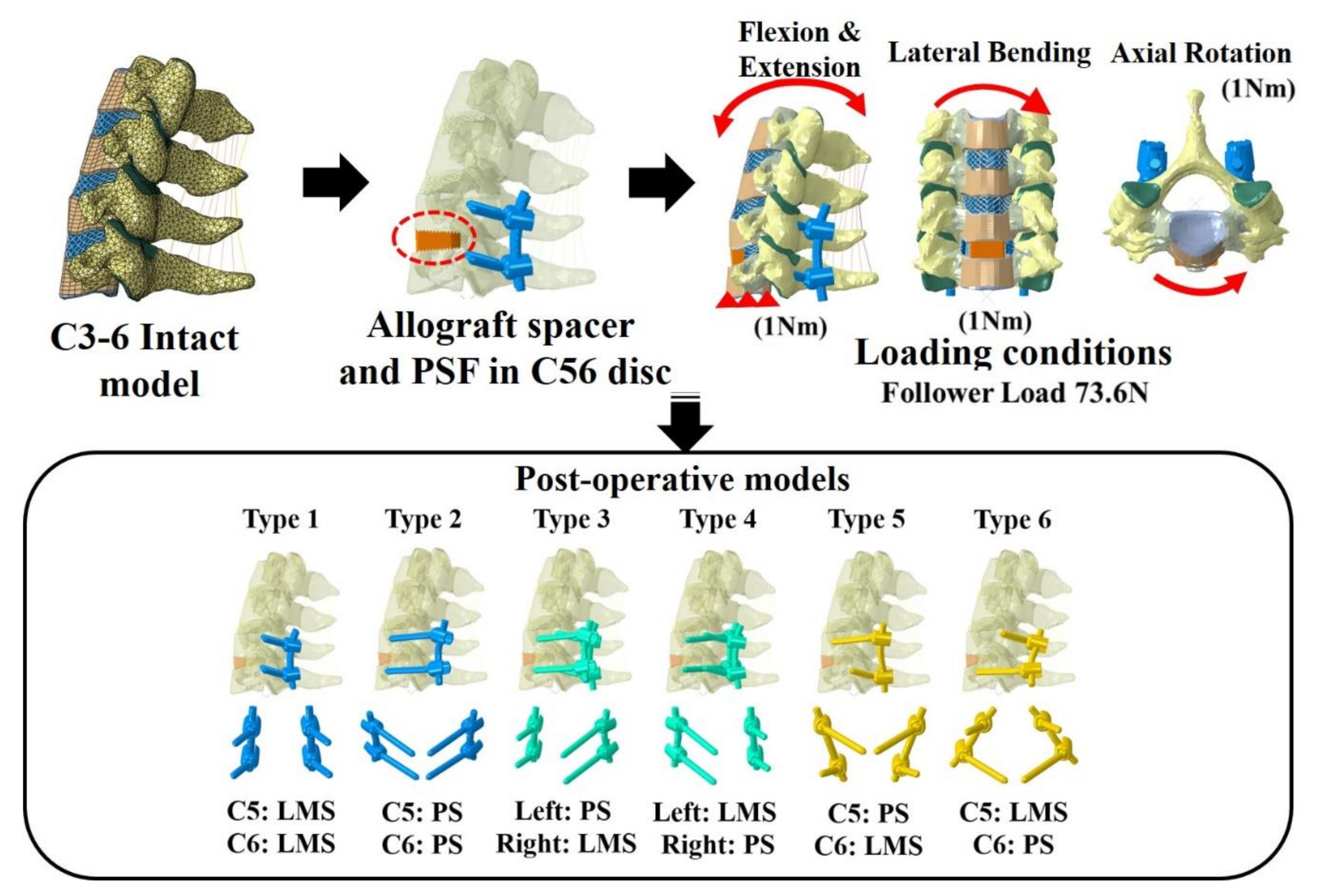
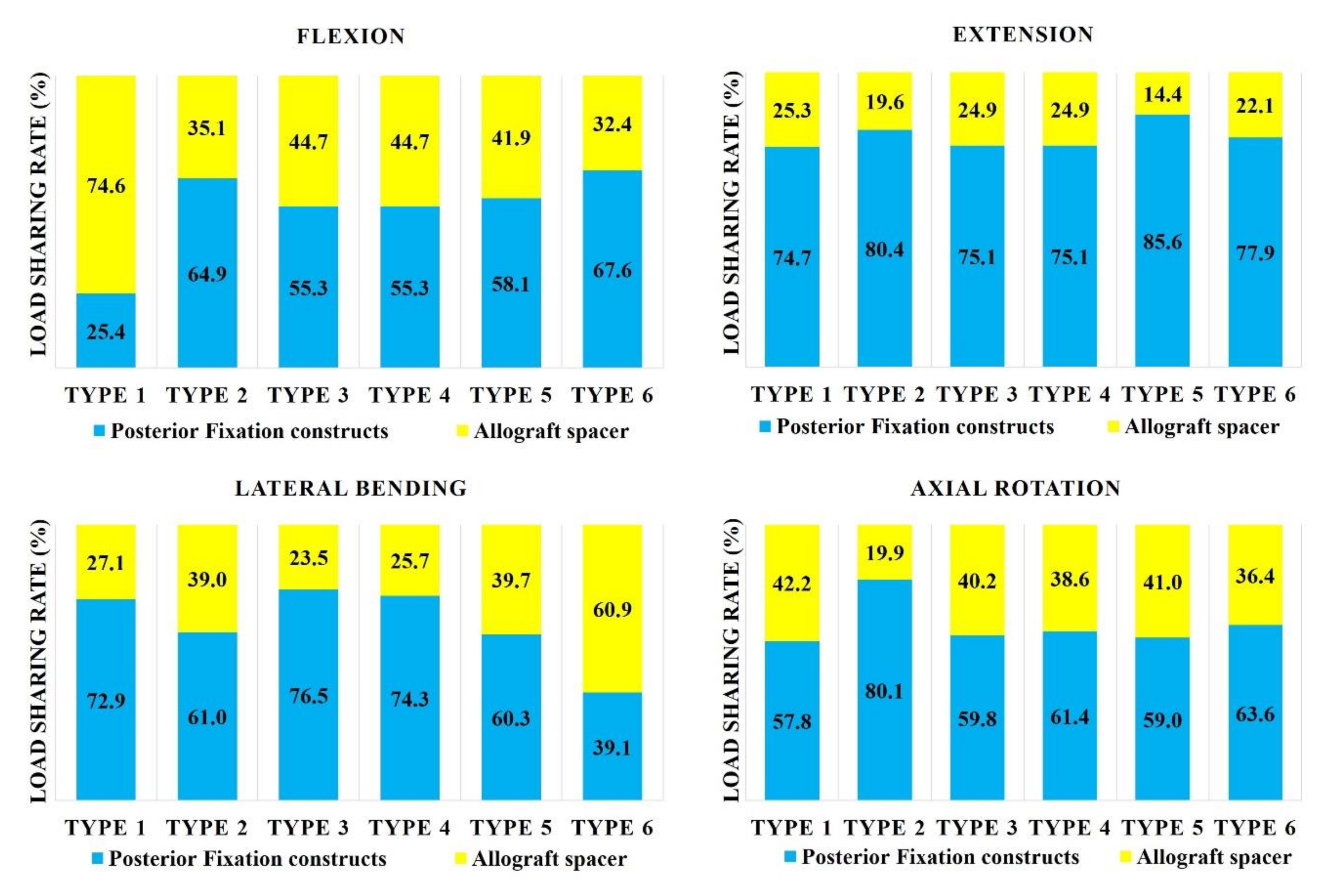
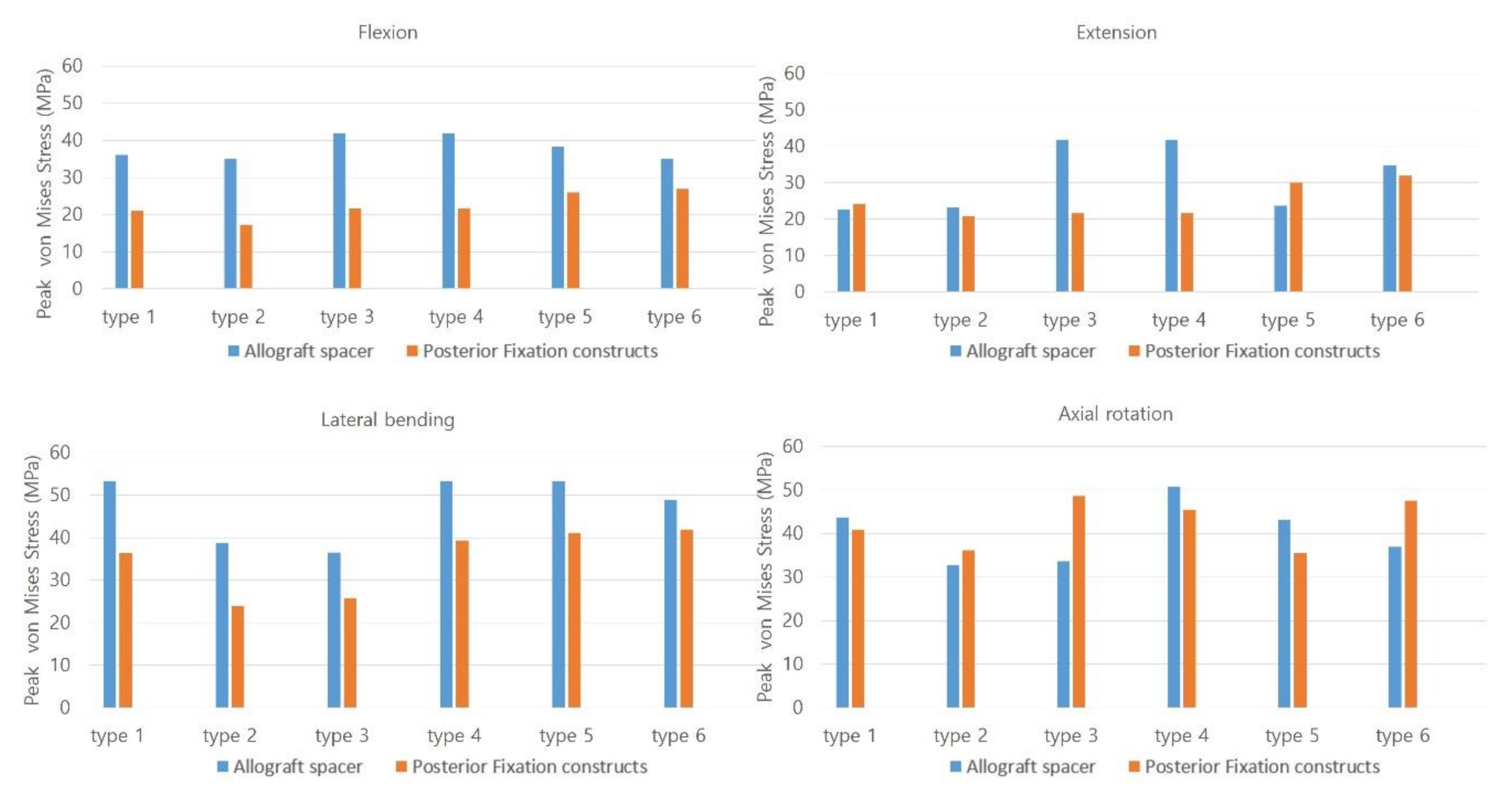
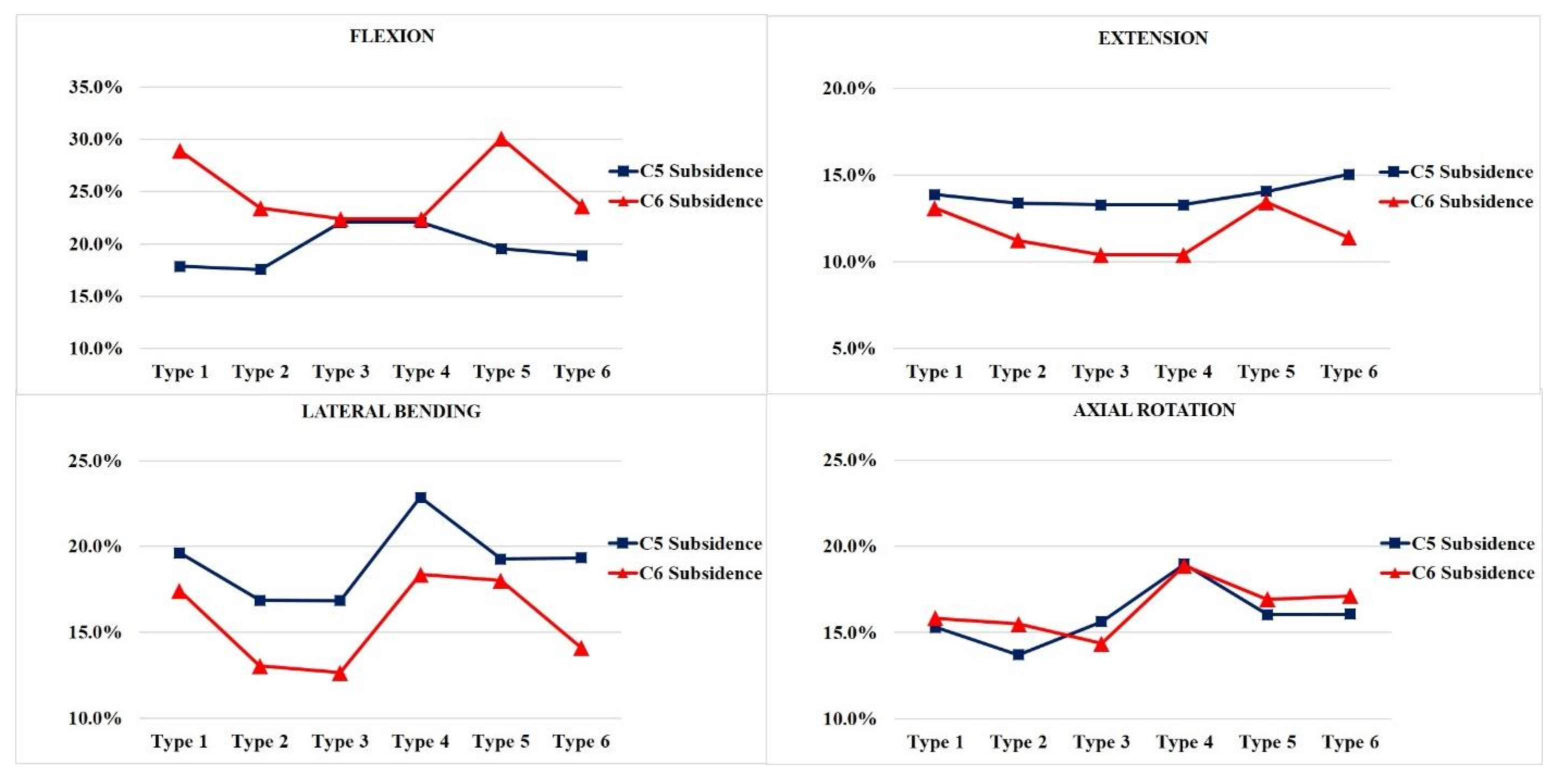
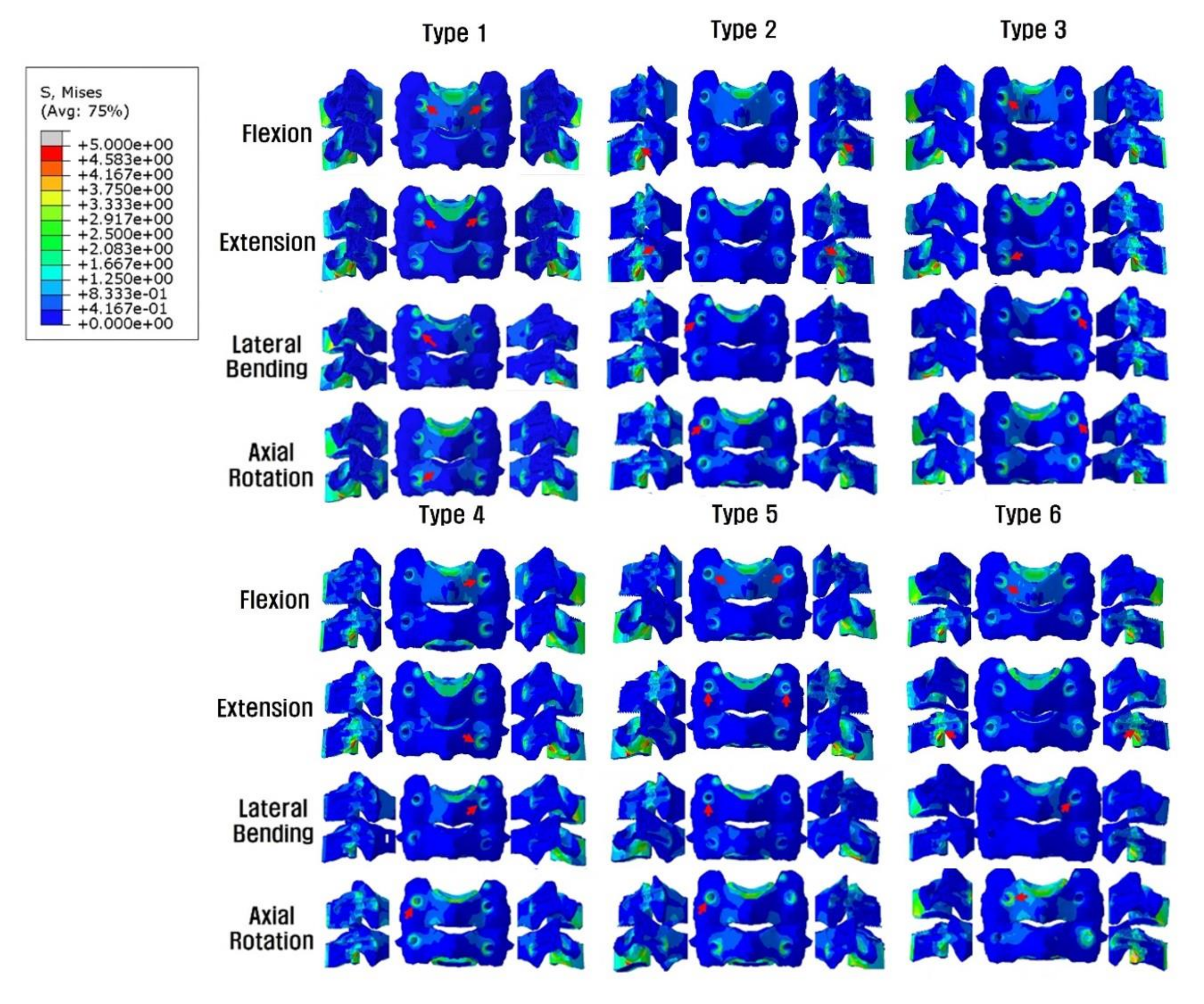
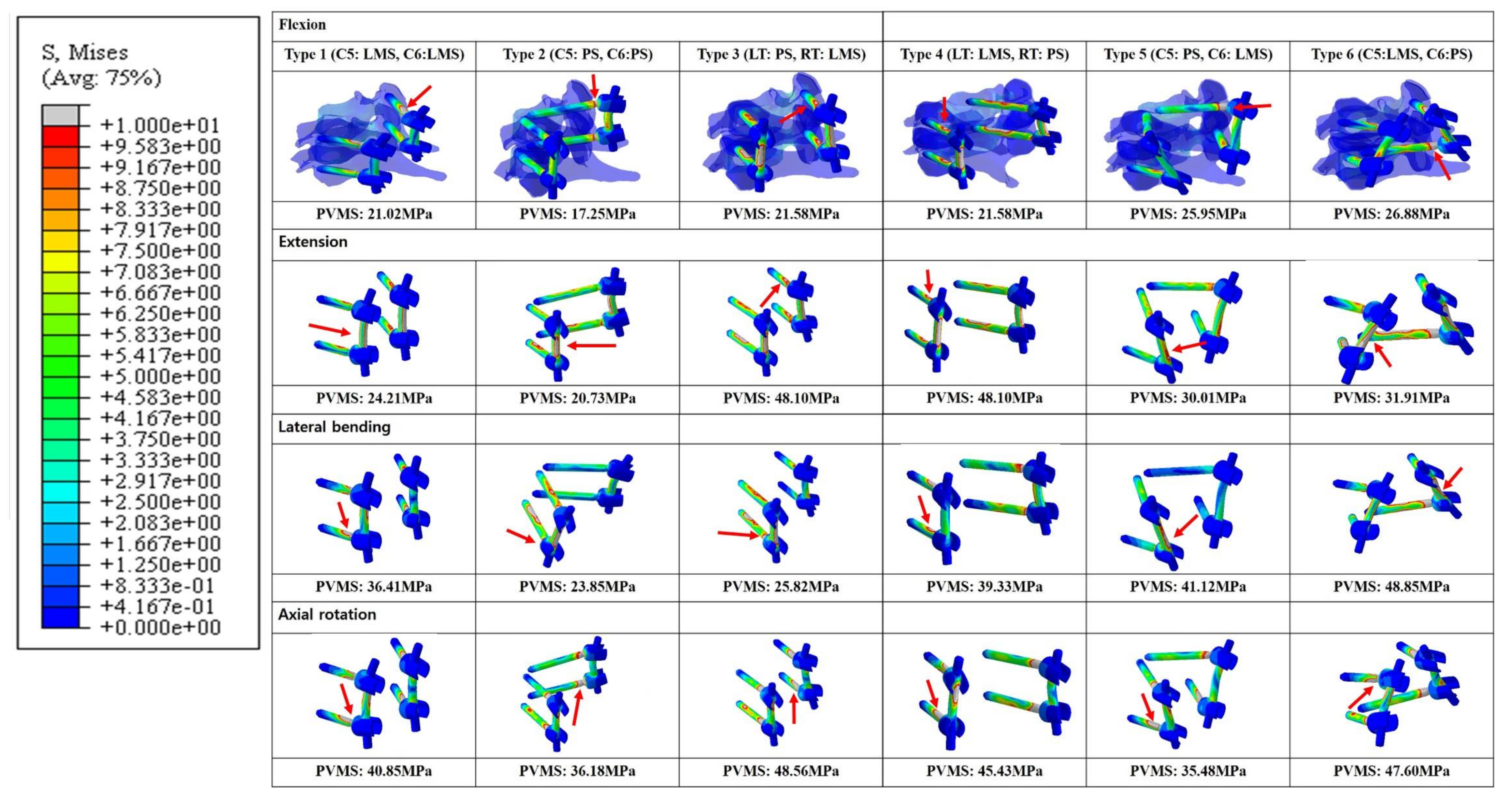
| ALL | PLL | LF | ISL | CL | |||||
|---|---|---|---|---|---|---|---|---|---|
| Load (N) | Disp. (mm) | Load (N) | Disp. (mm) | Load (N) | Disp. (mm) | Load (N) | Disp. (mm) | Load (N) | Disp. (mm) |
| 0 | 0 | 0 | 0 | 0 | 0 | 0 | 0 | 0 | 0 |
| 32 | 1.2 | 28 | 1.2 | 30 | 1.8 | 8.5 | 1.3 | 1.5 | 1.7 |
| 60 | 2.5 | 50 | 2.2 | 55 | 3.5 | 10 | 2.8 | 29 | 3.6 |
| 81 | 3.7 | 66 | 3.2 | 71 | 5.1 | 23 | 4.1 | 52 | 5 |
| 100 | 4.8 | 79 | 3.4 | 95 | 6.9 | 28 | 5.5 | 86 | 7.5 |
| 115 | 6 | 88 | 5 | 105 | 8 | 32 | 7 | 104 | 9.5 |
| Component Name | Young’s Modulus (MPa) | Poisson’s Ratio (ν) | Ref. |
|---|---|---|---|
| Cortical bone | 12,000 | 0.3 | [16] |
| Cancellous bone | 100 | 0.29 | [13] |
| End plate | 500 | 0.4 | [17] |
| Pedicle | 5000 | 0.3 | [19] |
| Posterior element | 3500 | 0.29 | [11] |
| Annulus matrix | 4.2 | 0.45 | [17] |
| Annulus Fibers | 500 | Cross-sectional Area 0.1(mm2) | [14] |
| Nucleus pulposus | 1.0 | 0.499(Incompressible) | [17] |
| Allospacer(Femoral cortical bone) | 18,200 | 0.38 | [20] |
| Allospacer(Femoral cancellous bone) | 389 | 0.3 | [20] |
| Posterior screw(Ti6Al4V ELI) | 110,000 | 0.35 | [21] |
Publisher’s Note: MDPI stays neutral with regard to jurisdictional claims in published maps and institutional affiliations. |
© 2020 by the authors. Licensee MDPI, Basel, Switzerland. This article is an open access article distributed under the terms and conditions of the Creative Commons Attribution (CC BY) license (http://creativecommons.org/licenses/by/4.0/).
Share and Cite
Lee, S.-B.; Lee, H.-M.; Park, T.-H.; Lee, S.J.; Kwon, Y.-W.; Moon, S.-H.; Lee, B.H. Biomechanical Comparison of Posterior Fixation Combinations with an Allograft Spacer between the Lateral Mass and Pedicle Screws. Appl. Sci. 2020, 10, 7291. https://doi.org/10.3390/app10207291
Lee S-B, Lee H-M, Park T-H, Lee SJ, Kwon Y-W, Moon S-H, Lee BH. Biomechanical Comparison of Posterior Fixation Combinations with an Allograft Spacer between the Lateral Mass and Pedicle Screws. Applied Sciences. 2020; 10(20):7291. https://doi.org/10.3390/app10207291
Chicago/Turabian StyleLee, Soo-Bin, Hwan-Mo Lee, Tae-Hyun Park, Sung Jae Lee, Young-Woo Kwon, Seong-Hwan Moon, and Byung Ho Lee. 2020. "Biomechanical Comparison of Posterior Fixation Combinations with an Allograft Spacer between the Lateral Mass and Pedicle Screws" Applied Sciences 10, no. 20: 7291. https://doi.org/10.3390/app10207291





